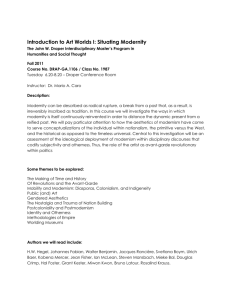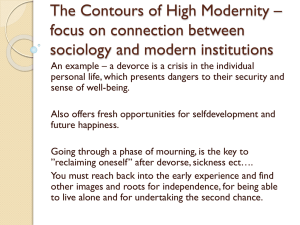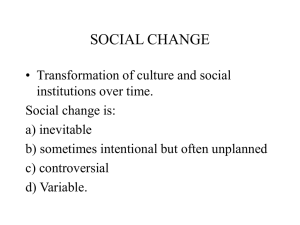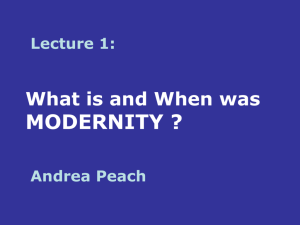ModernityHelsinki13Pres
advertisement
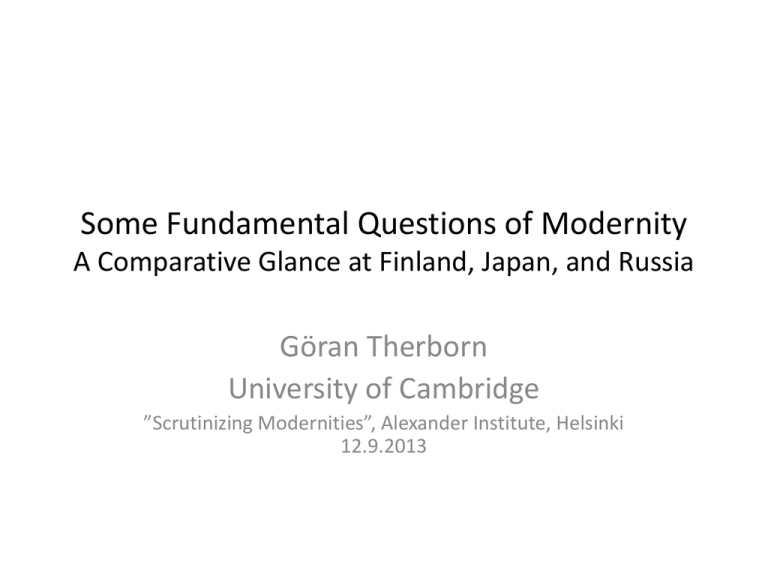
Some Fundamental Questions of Modernity A Comparative Glance at Finland, Japan, and Russia Göran Therborn University of Cambridge ”Scrutinizing Modernities”, Alexander Institute, Helsinki 12.9.2013 Modernity: Making Use of a Concept • Avoiding redundant labelling • Avoiding idiosyncracy: etymological respect • Opening investigations A time culture, focusing on the present & oriented towards a new thisworldly future, questioning/rejecting the authority of the past Breakthroughs of Modernity • Conception of History – Linear , Evolutionary: 18th c. Enlightenment • Cognition – Ancient authority rejected: Vesalius, Bacon, Descartes et al : late 16thearly 17th c. • Aesthetics – Partial breaks: Renaissance; Quérelle des anciens et des modernes – Full break, late 19th c.: Baudelaire, Impressionism, Art Nouveau • Economics – Radical agricultural improvement; industrialization • Politics – Re-form & re-volution turned to the future – Politics of nations, nation-states 4 Major Pathways to Current Modernity & 2 Major Hybrids by Pattern of Conflict • The European – Internal: the nation/people vs. the prince & (mainstream) aristocracy • The Settler ”New World” – The settler nation vs the motherland prince & the natives • The Ex-Colonial – The colonized people turning the modern politics of the colonizers against them • Reactive Modernization:Japan, Siam, Abbyssinia – Section of existing elite importing national politics to defend traditional realm Hybrids: Russia : European internalism & Reactive Modernization China: Failed RM, part anti-Colonial, part European-type class war Enduring Consequences of the Roads to Modernity I European Internalism • Conception of the nation – Constructed, as historically rooted in language, culture, experience • Leading force of the nation – The (stratified) people • Notion of representative government – Rights of the people Reactive Modernization • Conception of the nation – Given, Ex-subjects of the realm • Leading force of the nation – The government & associated (economic) elites • Notion of representative government – Instrumental: Ensuring social cohesion & state force Enduring Consequences of the Roads to Modernity II European Internalism • Role of religion & the supernatural – Path towards thorough secularization & disenchantment • Social relations, (in)equality – Salience of class & class organization – Path towards general equalization Reactive Modernization • Role of religion & the supernatural – Re-vitalization of state religion, Reproduction of folk religion & of magical beliefs • Social relations, (in)equality – Marginalization of class – Reproduction of existential inequality (status hierarchy, deference, misogyny) – Delimitation of economic inequality for cohesion Finland on the European Road • F belongs to the Nordic cluster of gradualist, negotiated political modernity (l917-18 civil war an aberration, due to then part of Russian empire in revolution) • Also to the Nordic cluster of class, with strong farmers & limited distance popular classes-bourgeoisie • Within Russia F was a vanguard of modern development, in Nordic region a latecomer to prosperity • Part of the East-Central European variant of national language development & change • F was culturally well connected & a Nordic centre of aesthetic modernism: architecture, poetry, design Japan: The Paradigmatic Case of Reactive Modernization The Charter Oath of l868: • “Evil customs of the past shall be abandoned and everything shall be based upon the just laws of Nature. • Knowledge shall be sought throughout the world …” The universalist modern program is then cut down into characteristic Japanese particularism, continuing : • “…so as to strengthen the foundations of Imperial rule.” Japanese Specifics of the RM Road • Imperial ambition & capacity • Continuist ”embrace of defeat” • Preocupation with location & identity – Out of Asia, or Leading Asia? – Japanese ”overcoming of modernity”, Nihonjin ron and studies of Japaneseness The Russian Hybrid I. Set-Up • The European Mould – ”The Third Rome”, late 15th c. Italian architects in the Kremlin, 18th-19th c- dynastic intermarriages, upperclass Francophony – 1st half of l9th c.: the gendarme of Europe – European workingclass movement – A centre of early 20th c. European art modernism • The Experience of Backwardness – Outside medieval & Renaissance Europe – Overwhelming rurality – Serfdom & its pull-down socio-cultural effects • Bases of European Distanciation – Cultural: Slavicism & Orthodox Christianity – Spatial: Eurasian bridge The Russian Hybrid II. Consequences • Stalinist, statist RM overtaking the workingclass October Revolution – Revolutionary violence adding to violent dynamics of RM • The Khrushchevite project continuing catching up with & overtaking the West - & its imploding failure under Gorbachev – Social meaning of Communism underdeveloped • Post-Communist amalgamations of pre-revolutionary religion & deference and Soviet big power institutions & practices – Social reform perspective lost Prospects: After Modernism I. Current State • Finland – Goals achieved: Nordic prosperity, independence of Russia, standing in Europe – Lost: frontier of electronics & design • Japan – Achieved: economic world power – Lost: Chance of becoming No. 1 • Russia – Achieved: Return to big power status – Lost: parity with US, & chance of overtaking it Prospects: After Modernism II. Futures • Finland – Possibility of peaceful prosperous periphery without much need of modernism, though clouded by the fall/sale of Nokia and the coming structural decline of the pulp & paper industry • Japan – Difficulties to adapt to old age serenity, blocage of immigration, current attempt at nationalist growth unlikely sustainability – Improbable but still conceivable prospect of ”overcoming modernity”, as a secure, serene, aesthetic stationary state • Russia – Fragile economy, brittle political institutions, clearly in need of some futuristic modernist social project
